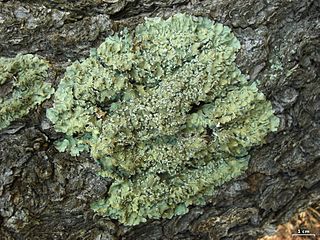
Parmelia is a genus of medium to large foliose lichens. It has a global distribution, extending from the Arctic to the Antarctic continent but concentrated in temperate regions. There are about 40 species in Parmelia. In recent decades, the once large genus Parmelia has been divided into a number of smaller genera according to thallus morphology and phylogenetic relatedness.

The Parmeliaceae is a large and diverse family of Lecanoromycetes. With over 2700 species in 71 genera, it is the largest family of lichen-forming fungi. The most speciose genera in the family are the well-known groups: Xanthoparmelia, Usnea, Parmotrema, and Hypotrachyna.

Myelochroa is a genus of foliose lichens in the family Parmeliaceae. They are commonly known as axil-bristle lichens. It was created in 1987 to contain species formerly placed in genus Parmelina that had a yellow-orange medulla due to the presence of secalonic acids. Characteristics of the genus include tightly attached thalli with narrow lobes, cilia on the axils, and a rhizinate black lower surface. Chemical characteristics are the production of zeorin and related triterpenoids in the medulla. Myelochroa contains about 30 species, most of which grow on bark. The genus has centres of distribution in Asia and North America.

Flavopunctelia is a genus of foliose lichens in the family Parmeliaceae. The genus contains species that are widespread in temperate and tropical areas. The genus is characterised by broad, yellow-green lobes, point-like (punctiform) pseudocyphellae on the thallus surface, and bifusiform conidia. All species contain usnic acid as a major secondary chemical in the cortex. Flavopunctelia was originally conceived as a subgenus of Punctelia by Hildur Krog in 1982; Mason Hale promoted it to generic status in 1984.

Flavoparmelia is a genus of foliose lichens in the family Parmeliaceae. Because of their appearance, they are commonly known as greenshield lichens. The widely distributed genus contains 32 species. It was circumscribed by American lichenologist Mason Hale in 1986 to contain 17 former Pseudoparmelia species with broad lobes, usnic acid in the cortex, and isolichenan in the cell walls.

Canoparmelia is a genus of lichen-forming fungi in the family Parmeliaceae. The widespread genus contains about 35 species. Canoparmelia, a segregate of the parmelioid lichen genus Pseudoparmelia, was circumscribed by John Elix and Mason Hale in 1986.

Bulbothrix is a genus of lichen-forming fungi in the family Parmeliaceae. This genus is synonymous with Bulbothricella V.Marcano, S.Mohali & A.Morales. Bulbothrix was circumscribed by lichenologist Mason E. Hale in 1974 with Bulbothrix semilunata as the type species.

Parmelinella is a genus of lichen belonging to the family Parmeliaceae. The genus was circumscribed in 1987 by John Elix and Mason Hale as a segregate of Parmelina, from which it differs in having larger ascospores and containing salazinic acid. Although the genus had been assumed to be well-defined morphologically, a 2021 molecular phylogenetic study suggests that the generic delimitations need to be revised.

Parmotrema is a genus of lichen belonging to the family Parmeliaceae. It is a large genus, containing an estimated 300 species, with a centre of diversity in subtropical regions of South America and the Pacific Islands.

Punctelia is a genus of foliose lichens belonging to the large family Parmeliaceae. The genus, which contains about 50 species, was segregated from genus Parmelia in 1982. Characteristics that define Punctelia include the presence of hook-like to thread-like conidia, simple rhizines, and point-like pseudocyphellae. It is this last feature that is alluded to in the vernacular names speckled shield lichens or speckleback lichens.

Relicina is a genus of foliose lichens belonging to the large family Parmeliaceae. It contains 59 species.

Xanthoparmelia is a genus of foliose lichen in the family Parmeliaceae. Xanthoparmelia is synonymous with Almbornia, Neofuscelia, Chondropsis, Namakwa, Paraparmelia, and Xanthomaculina. This genus of lichen is commonly found in the United States, as well as Australia, New Zealand and Ecuador.
Parmotremopsis is a genus of lichen-forming fungi in the family Parmeliaceae. The genus was circumscribed in 1987 by lichenologists John Elix and Mason Hale.
Austroparmelina is a genus of foliose lichens in the large family Parmeliaceae. It contains species formerly placed in the genera Parmelina and Canoparmelia. All species of Austroparmelina have an Australasian-South African distribution.

Notoparmelia is a genus of foliose lichens in the family Parmeliaceae. It includes 18 species that grow on bark and rocks, and are mostly distributed in the Southern Hemisphere. The genus was created in 2014 as a segregate of Parmelia.
Bulbothrix meizospora is a species of foliose lichen in the family Parmeliaceae. It is found in Africa, Asia, and South America, where it grows on tree bark.
Xanthoparmelia salazinica is a species of lichen in the family Parmeliaceae. Found in South Africa, it was described as a new species in 1989 by American lichenologist Mason Hale. He classified it in Karoowia, a genus that has since been placed in synonymy with Xanthoparmelia following molecular phylogenetic analysis published in 2010.

Parmelina quercina is a species of foliose lichen in the large family Parmeliaceae. It is found in continental Europe.














